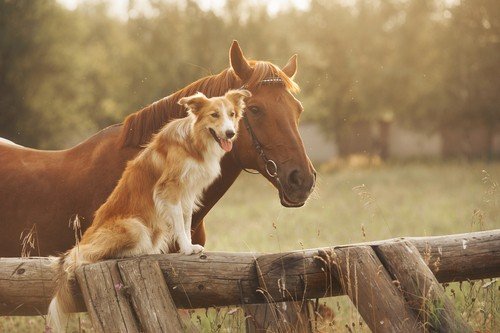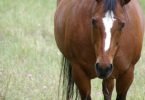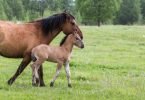Is horse weaving normal?
Why is my horse weaving?
Is weaving harmful for my horse?
Why is my horse weaving in the trailer?
If you have ever worried about these things, you have every reason to understand why horses weave and what does it indicate. Sometimes, it could be the sign of an underlying complication in the animal. At other times, it could just mean boredom.
If your horse is regularly weaving, you may want to know how to prevent weaving in horses. Regardless, if your horse weaving behavior is causing you stress, read on to learn more about it.
To know more about different behavior problems in horses, check this article “Most Common Behavior Problems in Horses“.
What is Horse Weaving?
When a horse is weaving in a stall, it is an example of abnormal stereotypical behavior. It could be a compulsive and repetitive behavior, serving no purpose. Horses may weave and roll the head and involuntary move the front legs and the neck. In some advanced cases, the hind legs could be involved too. Horses generally do this when they are standing at the stable door.
Weaving is a rhythmic swaying involving lateral excursion of the head and the neck, and concurrent shifting of weight between the front feet. The whole front part of the horse is involved along with its hindquarters.
Weaving is often called a stable vice, such as stall walking, kicking, or cribbing. While it is not usually harmful to the horse, you may prefer to make efforts and curb weaving behavior in the horse and improve its mental health.
However, horse weaving behavior is not necessarily the result of muscle problems due to rocking. In our fast-moving lives, we often fail to question those who are in touch with the animal always. Just like us, horses also have an urge to socialize and walk. Weaving could be a sign of boredom and restlessness.
Origin of Horse Weaving
The origin of weaving in horses is mainly social. However, there are some sub-types to consider, which would give us a fair idea as to how to stop horse weaving behavior.
Typically, horses weave in stable due to nervousness. When they spend long hours in the stable or the box, they get quickly bored and may weave. Frustration builds up to cause restlessness, thus triggering such tics.
When we change stable for horses, they may weave out of stress. Some horses are stressed when left alone. They may weave due to loneliness, the anxiety of being alone, and habitat changes. Considering that horses can be susceptible, these changes relate to their stereotypical behavior.
Why do Horses Weave?
It is not possible to point out a single reason for horse weaving. However, some evident and time-tested reasons could be causing such behavior. Whether your horse is weaving in trailer or field, reasons may not be the same. While some horses weave at feed time, others may not.
It is only possible to find a cure to horse weaving when you find the cause successfully.
Noted below are some probable horses weaving causes:
Boredom
Humans have contributed to breeding horses and training them to be smart and willing companions. However, we cannot ignore the fact that an intelligent animal, when cooped up in a stall for hours, may act negatively.
If you have reasons to believe that your horse is acting negatively due to boredom or lack of mental stimulation, try these:
- Increase exercise for your horse. Physical activity is not only good for the body but also the mind too. If your horse does not get the exercise it needs, consider seeking help. Free lunging, hand-walks, games with other horses can be fun activities for the horse.
- If your young horse is weaving, buy some toys. Toys entertain horses. Choose from stable items, but make sure they are safe for the horse to nip and kick. You can purchase balls of different sizes for young horses.
- Brush up your horse training skills. Learn new skills to train some tricks on your horse. Even simple methods can engage their mind and could be a fun way of interacting with the horse. Of course, your horsemanship shall also get a boost at the same time.
Less Social Interaction
Do you know, horses are social animals. They enjoy the company of other horses; however, horses that do not receive adequate social interaction may suffer from mental agony.
If there is a lack of herd mates, you may consider moving the horse to a better horse stable. However, if your horse must stay at home, bringing in a donkey, equine pasture puff, or a goat for a company could also improve mental health.
Captivity
Wild horses should not be kept in stables. Unfortunately, such is life for today’s domesticated equines. Depending on circumstances and location, your horse may spend more time in the stall, which could cause behaviors such as weaving.
By nature, horses prefer to roam around and forage. They spend days in the wild, walking around, searching for food. If you confine them for too long, make sure you hand-walk them more often.
Isolation
Isolation could also trigger stress and anxiety in horses. Without medical reasons, prefer not to isolate your horse from the herd. If you want to keep it in the stable, make sure there is always company.
Another tip is to use a stall guard instead of a door made of solid wood. It helps the horse to get more attention from neighbors.
Stress
Anything that leads to stress could trigger horse weaving. For example, if you are moving to a new location, weaning a foal from the mother, or adding a herd mate, it could potentially have a long-lasting effect on the well-being of the horse.
Prepare your horse for such stressful situations. Train them well and make them comfortable when you move or visit a vet.
Changes in the Stable
Not all horses can handle changes well. Take adequate time to train the horse properly. Give it some time to adjust to the new location or management team around.
You may not want to change the diet routine or exercise habits of the horse abruptly. Such a change could lead to both mental and physical health problems. Also, give some time to the horse to adjust to the new horses, new surroundings, and caretakers.
Experience from the Past
Sometimes, horses carry their experiences in their minds, which could trigger anxiety and weaving. For instance, as a foal, it may have been separated from the mother way too quickly during weaning. While it is not possible to control anything that happened in the past, you may want to find out more about their weaving habits.
Is there any cure for horse weaving?
Like all other stereotypical behaviors in horses, weaving is not curable. However, it may be possible to manage the behavior with proper attention and care. Over time, the behavior may disappear for good.
Sometimes, weaving could be a temporary phase brought about by a sudden change in the horse’s daily routine. If you have moved the horse recently, change its food habits and exercise routine. You may also add a significant change to its daily life, and give it some time to adjust to the new phase.
Horse weaving behavior may disappear in time as it settles down in the new environment, amongst new people and herd mates. However, if you are still concerned, or you feel something is wrong, call your vet immediately for professional advice.
Is Horse Weaving Behavior Contagious?
Scientifically, there is little evidence directing towards weaving being contagious. It would not be wrong to say that weaving is not at all a contagious problem. However, most horse owners are still worried about the nuances of such stereotypical behaviors.
Weaving is an abnormal neurological response, often sparked by some past events. Horses kept in a similar condition may be at risk for the same behavior, but most likely due to common and coincidental stable management practices.
Is Horse Weaving Dangerous to the Horse’s Health?
Though weaving is a behavioral issue, it is rarely harmful to the physical health of the horse. If the weaving were temporary, there would not be any lasting effects.
However, if your horse is weaving for a very long time, it may suffer some uneven hoof wear, damage their joints, and affect the floor of the stable.
Prolonged weaving may cause loss of condition, poor performance, strained ligaments, and joint deformities. Keep an eye on the horse’s feet to monitor signs of lameness. If you suspect lameness or similar signs, contact your vet immediately.
How do I know whether my horse is weaving or stall walking?
During horse weaving, it stands on the spot; however, while stall walking, the horse weaves from side to side and may walk up and down. Despite the name, stall walking does not mean being confined to the stable. Even horses at the pasture may pace up and down along the fence.
Just like weaving, it may be due to anticipation, stress, or maybe inherited. Likewise, most of the time, it can be prevented or stopped similarly.
Should I Buy a Weaving Horse?
Buying a horse with a stable vice, such as weaving, is a personal decision. It has complications too. Be honest, and know your abilities. If you are a first time, new equestrian, you may prefer not to purchase a horse that weaves, or requires extra care and attention.
Take a note of the stable setup too, if you know that the horse has a vice. There should not be any source of triggers for the horse to weave in the stable. Consider a better alternative, or a companion, to make sure it is comfortable.
Weaving is a mild condition with fewer risks of severe health complications; you may require the veterinarian or trainer’s assistance to work on the issue.
What Can I Do to Stop My Horse’s Weaving?
The safest way to stop a horse from weaving is to observe its behavior and make the necessary and appropriate changes.
Manage Behavior
Proper exercise, training, and spending quality time to the horse can improve its behavior. Overall, you should try everything that could boost the horse’s mood and instill proper behavior.
Manage the Stable
Make sure the horse spends plenty of time outdoors, in the wild, with other horses. Isolation is the leading cause of horse weaving. Adding stall guards, windows, and companions to the stable could be helpful.
Manage the Pasture
Ensure that the weaving horse gets along well with its herd mates. They need not be good friends, but they should gel. If the horse is bullied or stressed in the barn, it might worsen the condition. The chances are that you might have to experiment to find a fit. Check how it is grazing. If the horse is standing in one spot and eating his meals, it is more likely that the horse would stand at the same spot and weave. If that is the case, consider feeding it at different locations to make it work for the food a little harder. Discover how to stop horse weaving here.
Tips to Prevent Horse Weaving
It is usually challenging to get rid of stereotypical behaviors in horses. Horse weaving behavior is also the same. However, once detected early, you must act quickly to prevent aggravation. Notice these signs:
- Laziness and lack of energy expenditure
- Rapid weight loss
- Uneven hoofs wear
- Asymmetrical neck and hand muscle development
- Joints overload
If you notice any of these early signs of weaving in horses, here is what you should do:
- Bring a sheep to the horse’s stable. While it may seem uncanny, it is a proven solution in many horse-riding schools. A sheep is a good company for a weaving horse.
- Change the number of hours spent in the box, paddock, club, or stables, although this may not be possible all the time, though it could be a great relief for the horse.
- Increase the number of hours of games and walking. Playing with toys such as giant balls can be a great help.
- Devise some essential homeopathy remedies for the horse’s condition. You not only want to cover up the cause of concern but ensure that the horse’s quality of life improves.
- Install anti-weaving bars, or V bars to stop a weaving horse. The V bar design is such that it prevents weaving. However, on the other side, it may make a horse feel more confined and increase stress. Hence, use a V bar only to stop horse weaving, not as prevention.
Without knowing the horse, its behavior, and characteristics, it is impossible to suggest the right solution. Even the most experienced person’s opinion may not be able to add any value or quality to the horse’s condition.
Conclusion
The first step to improve weaving behavior is to make some crucial changes to the lifestyle and the living environment of horses. It is a common belief that lack of companionship causes weaving. Studies prove that eliminating these issues may be useful in stopping horse weaving completely.
To summarize it, horse weaving originated long ago and is totally out of control now. It may be challenging to identify the trigger factors. It may not be feasible to make any changes as well. However, some management schemes could be useful in reducing the urge of weaving.
As far as subtle farrier swaying is, it could be the horse’s way of weaving with a foot held high in the air. Always consider this a sign of discomfort, though not a red alert.
Researchers are still studying the reasons behind horses develop weaving and other stereotypical behaviors. While some horses behave this way, others may not have any cause of concern.
However, it is a known fact that this type of behavior is neither learned by watching or mimicking others (horses) nor a genetic condition, but a combined effect of both. We also accept the fact that it is better to prevent stall walking or weaving right from the start. But if that is not possible, reducing cues and making changes to their daily routine may help them manage the undesirable behavior in a better way.
Monitoring their feeding time and exercise routine is also essential to give their minds busy. Sometimes, anticipation can also lead to weaving. So, any change to the otherwise predictable routine can be a great source of relief. Finally, if the condition is unmanageable, you should see a veterinarian and get some good advice. If the horse continues to weave for long, it could cause injury and deteriorate health.






